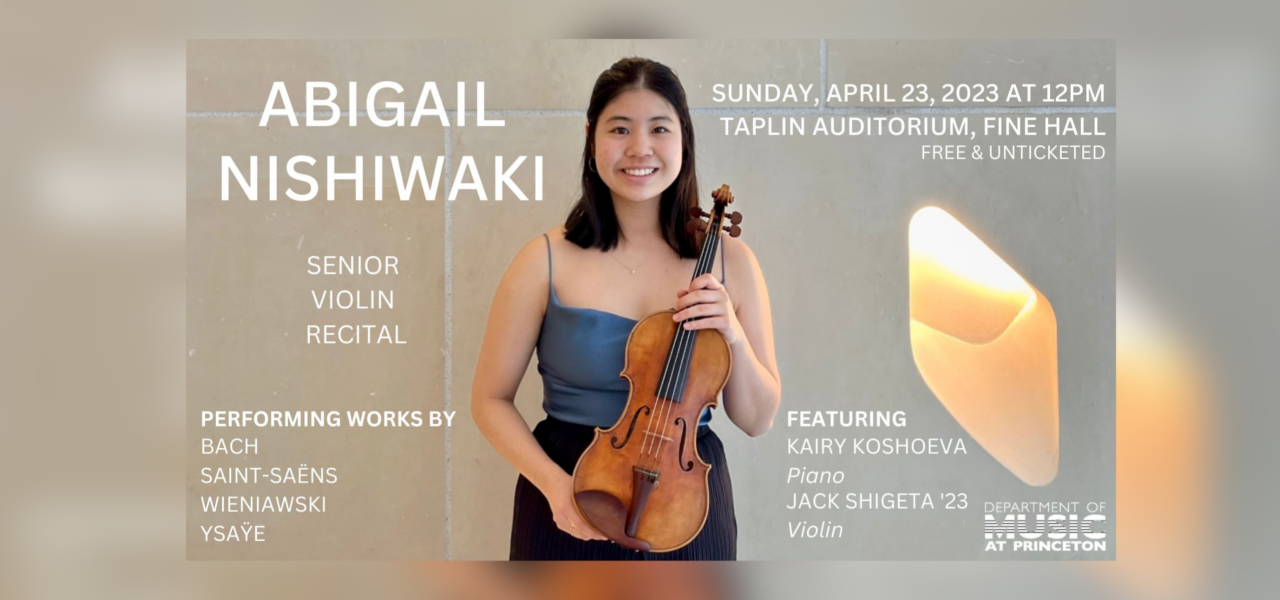Please consult our COVID-19 policies and resources for guidance on attending public performances.

Certificate Recital: Abigail Nishiwaki, Violin
Presented by Princeton University Music Department
date & time
Sun, Apr 23, 2023
12:00 pm - 1:00 pm
ticketing
Free, unticketed
- This event has passed.

Abigail Nishiwaki ’23 (Violin) performs a senior recital.
FEATURING
JACK SHIGETA ’23, Violin
KAIRY KOSHOEVA, Piano
PERFORMING WORKS BY
BACH
SAINT-SAËNS
WIENIAWSKI
YSAŸE
Program
J.S. BACH Partita No. 3 in E Major, BWV 1006
EUGÈNE YSAŸE Sonata No. 3 in D minor, Op. 27, "Ballade"
HENRYK WIENIAWSKI Études-Caprices for 2 Violins, Op. 18 No. 2 in E flat Major
CAMILLE SAINT-SAËNS Sonata No. 1 in D minor, Op. 75
PROGRAM NOTES
J.S. Bach – Partita No. 3 in E Major, BWV 1006
The first three movements from the E Major Partita embody the brightness and joy
that is spring. The Preludio, which is perhaps one of the most famous movements
of Bach’s six partitas and sonatas, is an exuberant opening to the partita, with its
constant running 16th notes throughout the movement. Next, we have the Loure –
a slow French dance in triple time – with a beautiful lilt that is a relaxing respite
before transitioning into the third movement. The Gavotte en Rondeau is a joyous
theme and variations, providing a sweet ending to round out this trio of
movements.
Eugène Ysaÿe – Sonata No. 3 in D minor, Op. 27, “Ballade”
Following the E Major Partita, we transition to the third of Ysaÿe’s six sonatas: the
“Ballade.” Inspired by Bach’s collection of six sonatas and partitas, Ysaÿe wrote this
series of sonatas and dedicated each one to a different famous violinist of his time.
An adept violinist himself, Ysaÿe composed his sonatas with a variety of virtuosic
techniques, making his works fun, but certainly challenging, to take on. While the
virtuosity of the piece speaks for itself, the sonata is also full of dissonance and
chromaticism, making it an exciting piece from start to finish.
Henryk Wieniawski – Études-Caprices for 2 Violins, Op. 18 No. 2 in E flat Major
This duet is a gorgeous combination of lyricism in the main E flat Major theme,
balanced by the ferocity of the G minor sections in between. I have been wanting
to play this duet since my first year of college, and I’m so glad I found a chance to
perform it before graduating. Having played with Jack in just about every concert
at Princeton, it only made sense to round out my last recital in the same way 🙂
Camille Saint-Saëns – Sonata No. 1 in D minor, Op. 75
To close out the recital, we travel through a journey of emotions in Saint-Saëns’s D
minor Sonata. The piece begins with the stormy Allegro agitato, consisting of
passionate outbursts and soaring melodies scattered throughout. This is
immediately followed by the Adagio which provides a tranquil contrast full of
dialogue between the violin and piano. Then, the second movement begins with a
playful waltz in the Allegretto moderato and ends with the dramatic Allegro molto
– a perpetuum mobile brimming with excitement and drama that adds great
panache to the piece and ends the sonata on a high note.
DEDICATION
I dedicate this senior recital to my family. Were it not for the support I have
received from my mom, dad, and sister, I would not be the musician, nor the
person, that I am today. So, I wanted to dedicate one piece to each of you. Mom –
the Gavotte en Rondeau has long-been your favorite piece of all time, so I knew
that it had to make it into this recital. Papa – I know how much you love the Saint-
Saëns sonata and how much you have been wanting me to play it, and I hope my
version is everything you hoped it would be! And Emily – I’m honestly not sure
how you feel about the Ysaÿe, but since it is a running joke between us (with all of
the passages you heard me practice and struggle with over and over again), the
Ysaÿe is for you. Thank you, Mom, Papa, and Emily, for everything! I love you!
PROGRAM NOTES
J.S. Bach – Partita No. 3 in E Major, BWV 1006
The first three movements from the E Major Partita embody the brightness and joy
that is spring. The Preludio, which is perhaps one of the most famous movements
of Bach’s six partitas and sonatas, is an exuberant opening to the partita, with its
constant running 16th notes throughout the movement. Next, we have the Loure –
a slow French dance in triple time – with a beautiful lilt that is a relaxing respite
before transitioning into the third movement. The Gavotte en Rondeau is a joyous
theme and variations, providing a sweet ending to round out this trio of
movements.
Eugène Ysaÿe – Sonata No. 3 in D minor, Op. 27, “Ballade”
Following the E Major Partita, we transition to the third of Ysaÿe’s six sonatas: the
“Ballade.” Inspired by Bach’s collection of six sonatas and partitas, Ysaÿe wrote this
series of sonatas and dedicated each one to a different famous violinist of his time.
An adept violinist himself, Ysaÿe composed his sonatas with a variety of virtuosic
techniques, making his works fun, but certainly challenging, to take on. While the
virtuosity of the piece speaks for itself, the sonata is also full of dissonance and
chromaticism, making it an exciting piece from start to finish.
Henryk Wieniawski – Études-Caprices for 2 Violins, Op. 18 No. 2 in E flat Major
This duet is a gorgeous combination of lyricism in the main E flat Major theme,
balanced by the ferocity of the G minor sections in between. I have been wanting
to play this duet since my first year of college, and I’m so glad I found a chance to
perform it before graduating. Having played with Jack in just about every concert
at Princeton, it only made sense to round out my last recital in the same way 🙂
Camille Saint-Saëns – Sonata No. 1 in D minor, Op. 75
To close out the recital, we travel through a journey of emotions in Saint-Saëns’s D
minor Sonata. The piece begins with the stormy Allegro agitato, consisting of
passionate outbursts and soaring melodies scattered throughout. This is
immediately followed by the Adagio which provides a tranquil contrast full of
dialogue between the violin and piano. Then, the second movement begins with a
playful waltz in the Allegretto moderato and ends with the dramatic Allegro molto
– a perpetuum mobile brimming with excitement and drama that adds great
panache to the piece and ends the sonata on a high note.
DEDICATION
I dedicate this senior recital to my family. Were it not for the support I have
received from my mom, dad, and sister, I would not be the musician, nor the
person, that I am today. So, I wanted to dedicate one piece to each of you. Mom –
the Gavotte en Rondeau has long-been your favorite piece of all time, so I knew
that it had to make it into this recital. Papa – I know how much you love the Saint-
Saëns sonata and how much you have been wanting me to play it, and I hope my
version is everything you hoped it would be! And Emily – I’m honestly not sure
how you feel about the Ysaÿe, but since it is a running joke between us (with all of
the passages you heard me practice and struggle with over and over again), the
Ysaÿe is for you. Thank you, Mom, Papa, and Emily, for everything! I love you!

